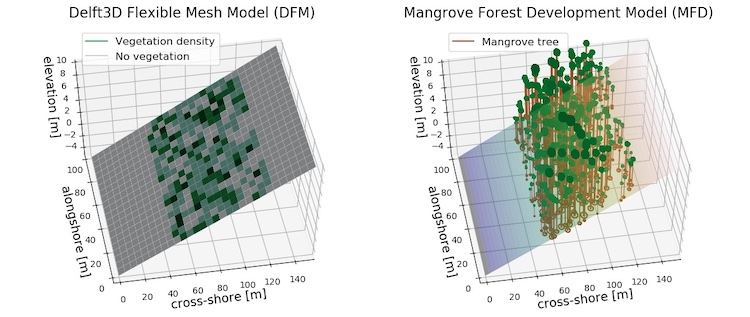R. Gijsman1*, E.M. Horstman1, D. van der Wal1,2, K.M. Wijnberg1
1 University of Twente,
2 NIOZ
Introduction
Mangrove forests can grow in the intertidal area of sheltered (sub)tropical shorelines. They can attenuate wave energy and stabilise shorelines, but they can also regenerate after storm impacts and adapt to changes in environmental conditions. These resilient and adaptive capacities of mangroves make them promising nature-based solutions for flood risk reduction in a changing climate. However, mangroves are also vulnerable ecosystems and (the persistence of) their flood risk reducing capacities may vary largely when environmental impacts or changes exceed their natural resilience. As a result, the implementation of mangroves as a solution for flood risk reduction requires a comprehensive understanding of how mangroves will respond to variations in environmental stressors such as hydrodynamic forcing. To date, process-based models to assess and predict biophysical responses of mangroves to hydrodynamic forcing are lacking. This study considers the development of a new numerical modelling approach to simulate hydro- and morphodynamic processes as well as biophysical interactions in mangroves.
Methods
The study combines the hydro- and morphodynamic model Delft3D Flexible Mesh (DFM) and an individual-based Mangrove Forest Development (MFD) model (Figure 1). The DFM model simulates the propagation of water levels and waves as well as resulting morphodynamics on a spatial grid. Simultaneously, the MFD model considers the establishment, growth and mortality of individual mangrove seedlings and trees on a sub-grid scale. The approach includes the interactions between the trees, hydrodynamics and morphodynamics through an online coupling between DFM and the MFD, while the development of the mangrove forest is based on tree-to-tree interactions.
Results and Outlook
The first results of the coupled DFM-MFD model provide insights in cross-shore mangrove forest dynamics along an elevation gradient, in response to varying inundation periods (Figure 1). Different stressors to mangrove development are currently being incorporated in the model. Future work aims at model calibration and validation through field measurements and remote-sensing observations to monitor seedling establishment and forest development, respectively. Eventually, this model will provide a useful tool to explore the response of mangroves to variations in hydrodynamic forcing on short (e.g. storms), medium (e.g. seasonality) and long timescales (e.g. sea level rise).

Figure 1: Mangrove vegetation represented in grid-based DFM model (left panel) and individual-based MFD model (right panel)
I. Surname1*, F.N. Another-Surname2 , Y. Next-Surname2
1 University Name, Country; 2 Organization Name, Country
* Corresponding author: mail.name@organization.org


